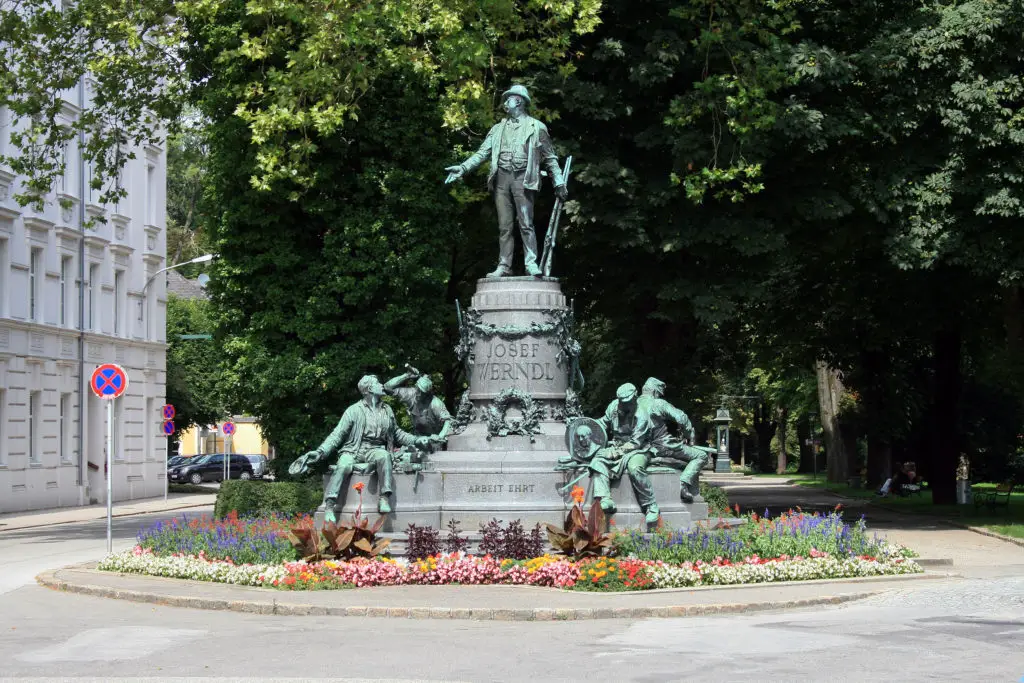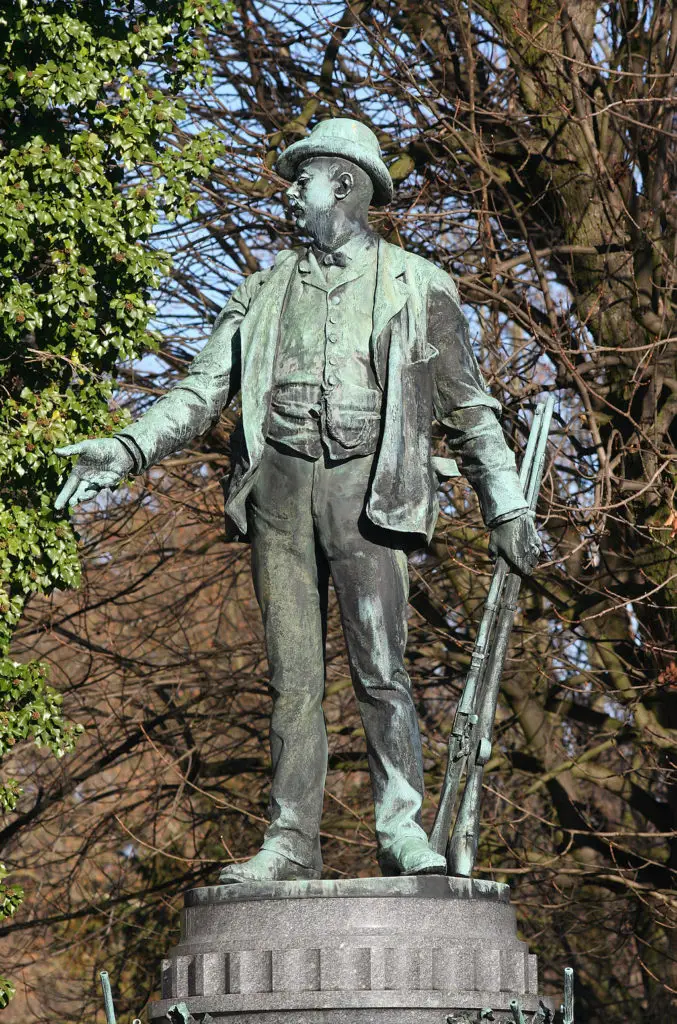Our research on Czechoslovak and Bohemian gun designs and designers has caused us to dive surprisingly deep into Austro-Hungarian arms. A lot of the key designers of Habsburg empire were either Czechs (ethnically) or were ethnic Germans resident in the majority-Czech Kingdom of Bohemia, one of many small historical kingdoms subsumed into vassalage to the Austrian and Hungarian dual crowns. We’re going to see some designs that the ethnic Czech Austro-Hungarian citizen Karel Krnka worked on.
Here’s Ian from Forgotten Weapons, boldly holstering a Roth-Steyr 1907 (primarily designed by Krnka, who presumably got paid, if not credited) for a three-gun match. “Boldly” because the gun is a little, uh, different, from what others are running. It has good sights — for 1907 — but a fixed ten-shot magazine reloaded by stripper clips.
Ian did alright, considering he was short about one stripper clip to really shoot the
Now, let’s get on with the 19th Century Werndl rifle. Designed by Josef Werndl and Karel Holub, it replaced the Wenzl rifle, which was a breech-loading conversion of the muzzle-loading Lorenz rifle-musket (which was widely used by both sides as a substitute weapon in the US Civil War. The M1867 Werndl rifle went into production in Werndl’s new factory, which would put the town of Steyr on the world map. These following videos from the Hungarian Cap and Ball.eu channel use the M1867/77 variant, chambered for a larger-capacity 11mm (.41) cartridge and still in second-line use during the First World War.
From the above video, the conceptual but not mechanical similarity to the US Allin conversion/trapdoor and the British Snider system is obvious.
Josef Werndl was a remarkable character. From the design of the rifle, he built a manufacturing empire, the Österreichische Waffen Gesellschaft at Steyr, which became the great Steyr works. When he passed away, the grateful citizens of Steyr ercted a massive bronze statue showing Werndl on top, holding a brace of these rifles, while below him four workers build the guns.
Here’s a close up of old Joe:
Karel Krnka, the principal designer of Ian’s Roth-Steyr pistol, couldn’t break into the rifle cartel of Werndl’s OWG and Friedrich Mannlicher’s eponymous firm, so he decamped to Britain where he worked on repeater for a while, before returning to the Austrian Empire for the Roth-Steyr pistol job.
More Werndl shooting (and reloading):
Here they are making the steel ring at 100 meters with a pair of Werndls (one minute video):
And finally, here’s a look at the old girl’s terminal ballistics:
The 24-gram bullet retained 100% of its weight, mushroomed to twice its 10.9 mm (.41 caliber) diameter, and generally put a serious wound on the gelatin pack. The rifle was clearly a good equivalent of the other early single-shot, .40-50 caliber rifles of competing world powers at the time.
The Werndl rifle would be replaced in Austro-Hungarian service by the Mannlichers, which would be made in Werndl’s old plant in Steyr, and in a new one constructed in Budapest. But that’s another story!

Kevin was a former Special Forces weapons man (MOS 18B, before the 18 series, 11B with Skill Qualification Indicator of S). His focus was on weapons: their history, effects and employment. He started WeaponsMan.com in 2011 and operated it until he passed away in 2017. His work is being preserved here at the request of his family.



11 thoughts on “Shooting Austro-Hungarian Arms”
Links to Forgotten Weapons and Cap and Ball in one post: Nicely done.
At any rate, interesting rifle that I would love to shoot sometime. Not too common up here in Soviet Canuckistan unfortunately.
My current Brush Gun (with heavier bullets, the American Express Rifle) is a WWI-vintage M95 straight-pull carbine in 8x56R. 204gr at 2600+ is hardly slouchy stuff, and I can down- or up-load as needed. A scoop of Trail Boss, capped off with pillow batting and a soft lead 206gr roundnose, replicates a hot .357mag for close-range deer or popping varmints.
And that action! You wanna talk about STRONG, the M95 is right up there with the 1917 Enfield and the Arisakas. I’ve never yet heard of anybody blowing one up short of stuffing the cartridge with primacord.
Hognose, when the royalty checks for your first book start rolling in, you’re going to take a fact-finding trip to Eastern Europe for the next book and write it off, right?
-John M.
I was close to doing an Danube cruise with the old man this fall, with three days in Prague for research… but he is not sure he can take two weeks shipboard any more so our fall trip is probably going to be shorter, road-bound, and in the USA. I’m not sure where or when.
I’ve heard good things about those Euro river cruises. I have to say that they appeal to me a lot more than the mega-cruises whose ports of call all sound indistinguishable from one another.
-John M.
They’re also very reasonably priced if you shop. I’ve never been to Eastern Europe, unless you count driving the Autobahn Helmstedt-Berlin through East Germany and laughing at the VoPos from behind my US Forces license plate.
I like the way Ian switched from his left hand to his right hand at the end of Stage 1. Show off!
I think that was demanded by the stage, actually. But it does display one of the positive features of the Roth-Steyr, it’s pretty hand-agnostic. (It was designed specifically as a cavalry pistol, and a horse soldier often had other things to do with one hand, like swing or point a saber, or manage his horse’s reins.
As a goof, one of the local guys shot the action stage of the first Masters tournament with a 1911 …. Steyr.
(Reloads were not under time.)
(The Masters at the PASA range in Barry, IL was an attempt at a professional money match with spectator appeal, with major sponsorship by S&W, but also other companies. The first was in 1987.)
I lived 7 years overlooking the Danube, but I never took one of the cruises myself. I have heard it is something you should not do if you are on a diet since they feed you on a continuous basis. 27 August we are having a tour of the CZ factory in Uhersky Brod, so obviously they do let people in.
Back when I was a mere sprout of a Teenager, there was a serious fear that the .gov was going to seriously restrict the sale of black powder to civilians. There was a huge amount, for some reason, of 11mm Werndl ammo available, and I knew a bunch of guys who had bought cases of it.
Being a kid, I was able to score a fair amount of it by just asking the “old guys” (several of whom were straight home from Vietnam, and all of about 24…) for a few boxes of it. Almost all, if not all of it was packaged in the original boxes, and furthermore was in the en bloc clips designed for the first Austro-Hungarian Mannlicher, the M1885 (or was it M1886?) Anyway, I still have a bunch of it, as the only gun I could shoot it in was a rechambered Gew-71/84, and about half of the primers were dead anyway, so I gave up on both. What did go off though was accurate, expended a satisfying cloud of white smoke, and kicked wonderfully.
Obviously the plot to disarm American black powder shooters turned out to be an abject failure, so most of the fine “brown powder” is still sitting there in those 1887-dated cases. Lord only knows how much of that stock is still moldering away in basements and garages.